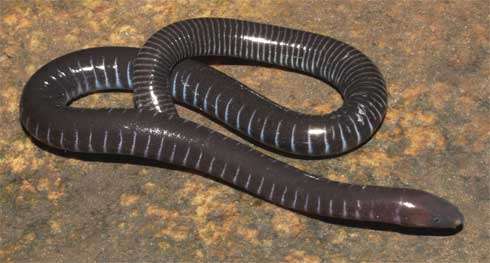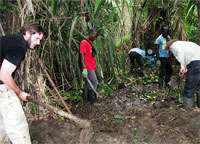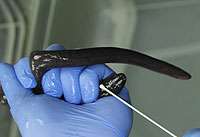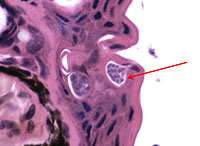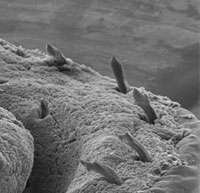This Cameroon caecilian species, Geotrypetes seraphini, tested positive for the fungus that can cause the deadly chytrid disease chytridiomycosis in frogs, toads, newts and salamanders.
It is known as the amphibian chytrid fungus and can cause a deadly disease that is decimating some of the world's frogs, toads, newts and salamanders. However, the fungus had not been detected in the other lesser-known major group of amphibians, the caecilians, until now.
An international team led by scientists at the Natural History Museum and Zoological Society of London (ZSL) have found the first cases of chytrid fungus infections in caecilians. They report their findings today in the journal EcoHealth.
More than 200 caecilians caught from the wild had DNA tests carried out on swabs of their skin to check for the amphibian chytrid fungus, Batrachochytrium dendrobatidis. The study included 29 caecilian species from 5 countries in Africa and South America, which is the largest genetic survey of this fungus in caecilians to date.
The team's results revealed the chytrid fungus in 58 individuals (nearly 30%). They examined the skin of some of the infected caecilians under the microscope to determine whether, and how, the fungus could infect the skin.
It was living in the skin in the same way it is known to in frogs and salamanders. Some of the caecilians in the study died from the chytrid disease, chytridiomycosis.
'The fungus was known to infect and potentially kill both the other major groups of amphibians, but we did not know if it definitively could infect caecilians in the wild, and whether it could potentially also kill them,' says Museum zoologist and lead researcher David Gower.
'We now know both of these are the case and so this potentially major threat needs to be taken into consideration in caecilian conservation biology.'
Museum scientists and locals digging for caecilians (pronounced si'silians) in Cameroon. Most species live buried in the soil and are little-studied.
Chytrid fungus and disease
The amphibian chytrid fungus can cause the lethal infectious chytridiomycosis disease.
A third of all amphibians in the wild are under threat of extinction and the chytrid disease is known to be a major contributor in many cases.
The amphibian chytrid fungus is a skin parasite - it lives in, and damages, the outer skin layers that contain large amounts of the protein keratin. This can be deadly because amphibians breathe and take up water through their skin.
'Our study's results were not surprising inasmuch as caecilians are amphibians and their skin is similar in many respects to that of frogs and salamanders,' says Gower.
Scientists took skin swabs from more than 200 wild-caught caecilians to test for the potentially deadly chytrid fungus.
'But caecilians are also very different from other amphibians in their body form and ecology, so it was something that needed to be tested'.
It is often thought that the amphibian chytrid fungus is spread in water. However, the caecilians that tested positive in this study live in the soil so the fungus is likely to also widespread on land.
The chytrid fungus infection shows up under the microscope - the red arrow points to the oval shaped space containing fungal spores within an infected area in the caecilian's skin.
Little-known caecilians
There are nearly 200 species of caecilians, which belong to the Order Gymnophiona (meaning 'naked snakes'). This compares with more than 6,000 species of frogs and toads, and more that 600 newts and salamanders. Caecilians are long and limbless, but unlike snakes, they lack the external scales of reptiles.
Caecilians have reduced eyes and a pair of unique sensory tentacles and some can grow to a 1.6 metres long. Most live in moist tropical soils as adults, but a few species in South America are fully aquatic. Some caecilians lay eggs but others give birth. In some species the hatchlings peel and eat the specially modified and nutrient-enriched skin of their mothers!
Some caecilian species have young that eat their mother's skin - they have specially adapted teeth shown in these scans.
Because most species of caecilians live buried in the soil, they are rarely studied and very little is known about most of them.
As a result, more than two thirds of caecilian species are 'Data Deficient' on the IUCN Red List because there is too little information to know if they are threatened or not.
This new research shows that the amphibian chytrid fungus now infects all the major groups of amphibians and means that scientists now need to consider it as a potential threat to caecilians in the wild.
Journal information: EcoHealth
Provided by Natural History Museum
